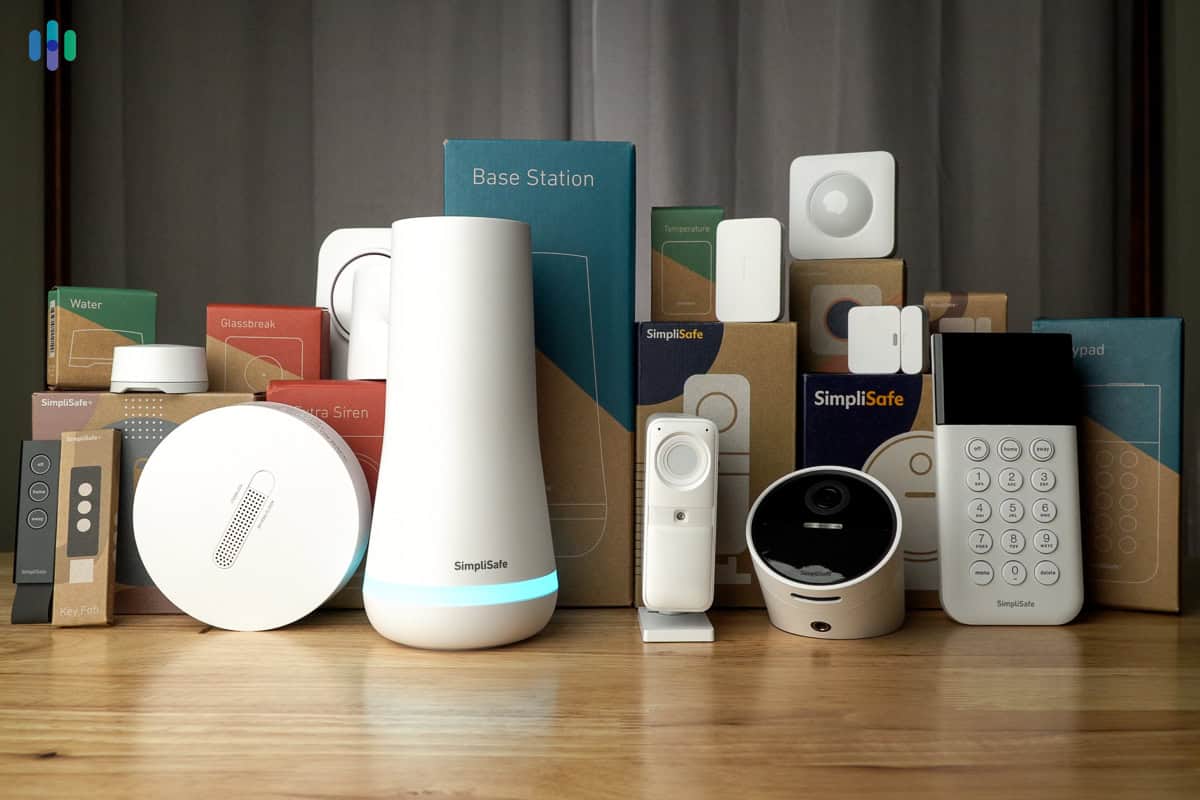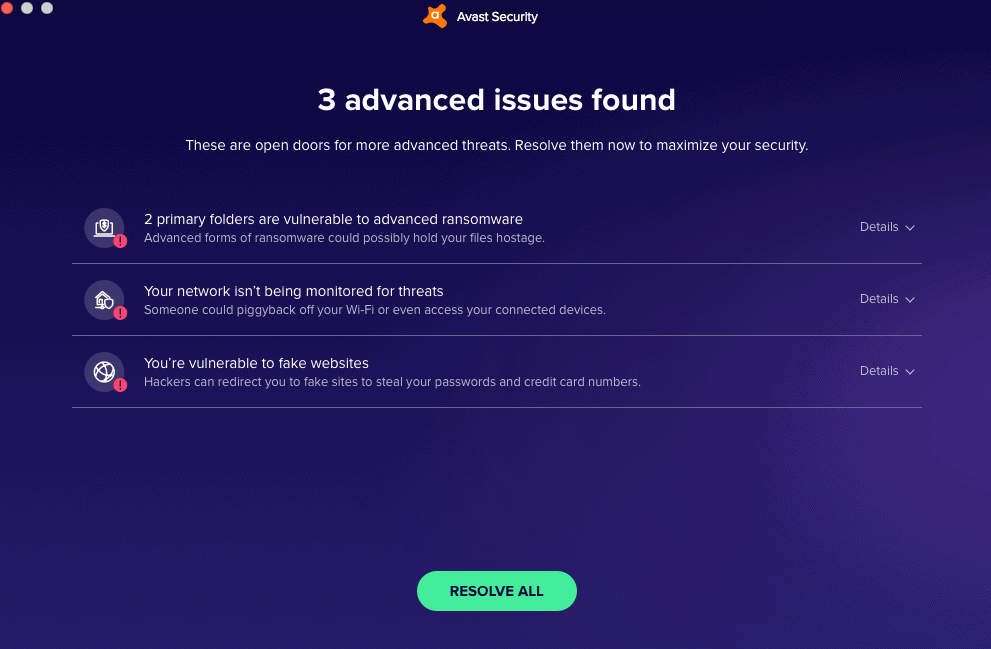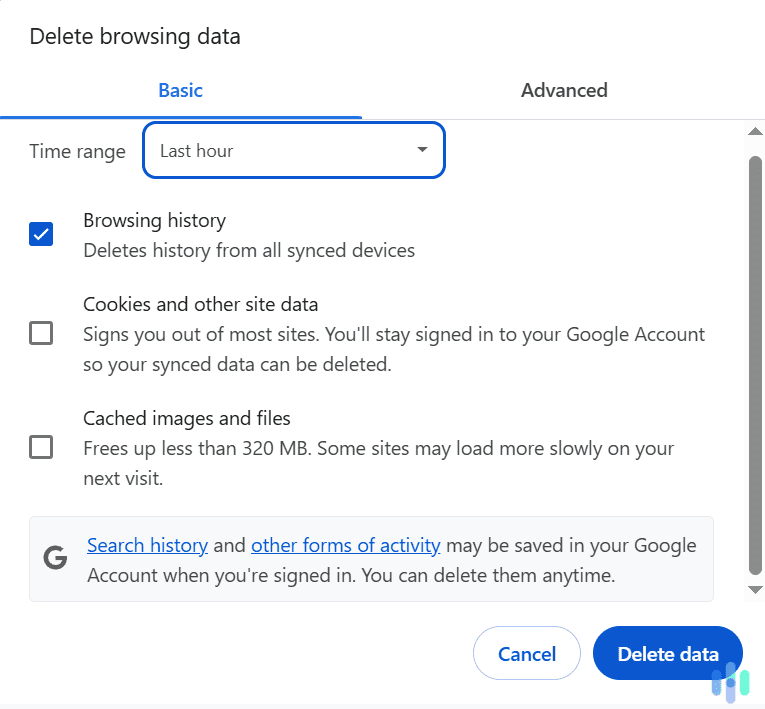Webroot Antivirus Review
 Aliza Vigderman, Senior Editor, Industry Analyst
&
Aliza Vigderman, Senior Editor, Industry Analyst
&
 Gabe Turner, Chief Editor
Last Updated on Nov 14, 2024
Gabe Turner, Chief Editor
Last Updated on Nov 14, 2024
What We Like
- Fast and efficient antivirus scans
- By default, automatically scans once an hour
- Firewall protection included, standard
What We Don't Like
- Low virus detection score from AV Labs
- Functionality involves moving back and forth between app and website
- Only detected one of our five test viruses
Bottom Line
While they might not be as recognizable as Norton or McAfee, Webroot piqued our interest with its low prices and its engaging, modern website. After we decided to review it, we did find some stuff we really liked, but there were definitely a few drawbacks.
>> Related: Compare Webroot vs Norton
One tick in the pros column was that Webroot is quick with its scans — our initial scan, which often lasts about an hour with other antivirus software, lasted just 22 minutes with Webroot. Was that a sign of efficiency, or did it compromise reliability for speed? Let’s find out in this hands-on test of Webroot antivirus.
Webroot Antivirus Features
| Price range | $2.49 – $3.17 per month |
|---|---|
| Scan types | On-access, On-demand |
| Blocks malware and viruses | Yes |
| Blocks phishing | Yes |
| Password manager | Yes |
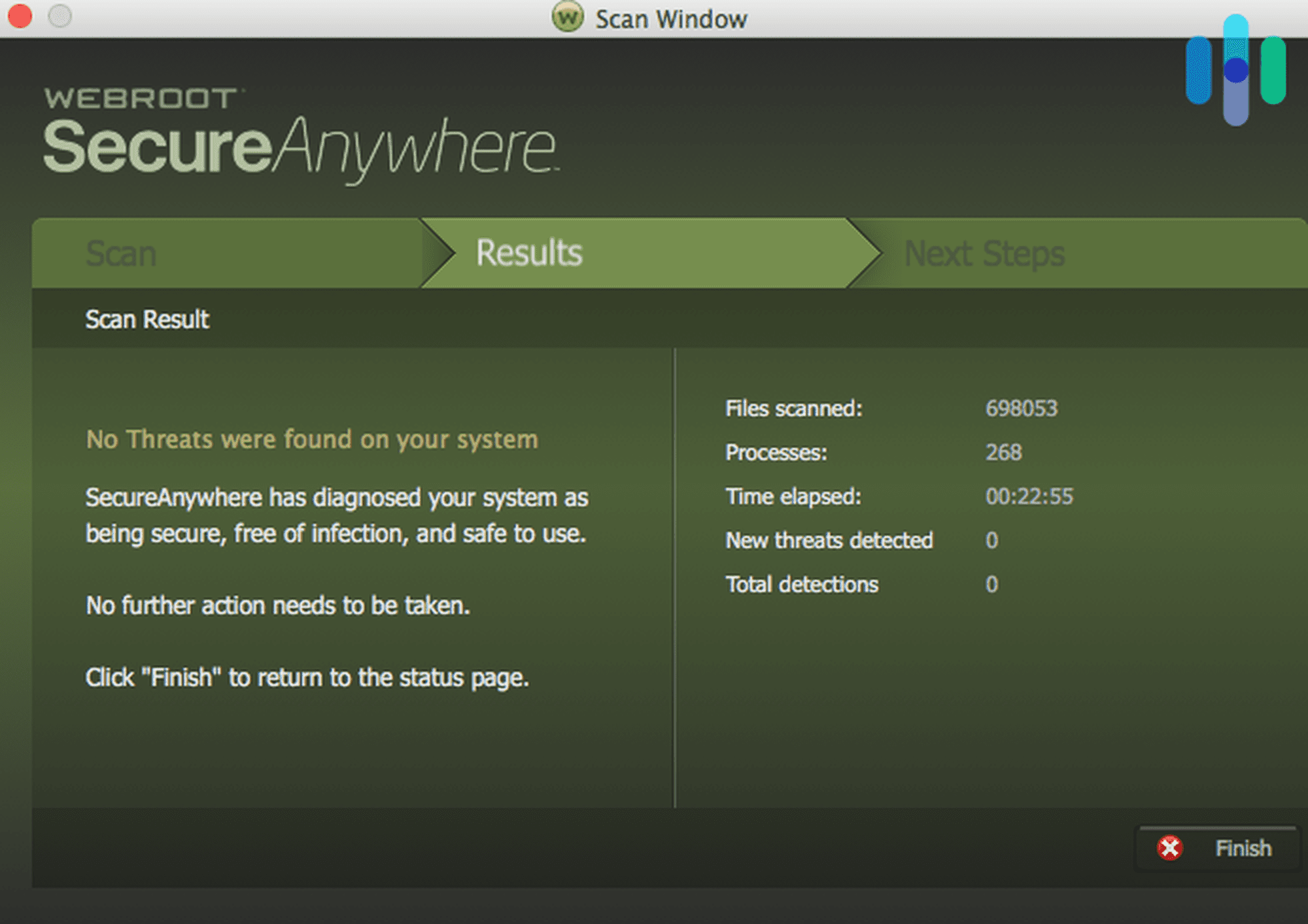
Overall Rating
- Detected 98.9 percent of widespread malware as of June 2020
- 14-day free trial
- 70-day money-back guarantee
Webroot Antivirus Overview
The speed at which it scans computers is probably the best thing about Webroot. Other than that, it’s a pretty mediocre antivirus. It also didn’t do that well in detecting live viruses on our computer, which is the whole point of having antivirus. For other options, check out our highest-rated antivirus brands here:
Webroot’s Security Breach: Are You Protected?
When we dive deep into antivirus software, it’s not only about our user experience, although that’s clearly an important part of our reviews. We also look into the company’s past to see if they’ve had any lawsuits, security vulnerabilities, or other events that would make us trust them less.
Believe it or not, even antivirus companies can and do get targeted by malware. It happened to Webroot in 2019 when it had a security breach where hackers spread ransomware across its customer systems.1 Webroot was able to contain this breach, fortunately, by mandating two-factor authentication to keep the hackers out. And to be fair, only a small number of customers were affected.
Aside from this security blip, we checked out Webroot’s privacy policy2 to see what data of ours they kept, and whether or not they shared it with third-party advertisers. Well, it turned out that they kept a lot of our information, including:
- Contact and account registration: Name, billing and shipping addresses, type of business, email address, phone number, security code, username.
- Financial and transactions: Card, banking or payment information, product and transaction information, purchase history.
- Content we provided: Any information in customer cloud storage
- Devices: Operating system, MAC address, device ID, browser type, IP addresses, websites visited, location information.
- Connecting and usage: License and account information, features utilized, session length.
- Misc: Any communications we have with Webroot, etc.
While this data is pretty standard for antivirus software, we wondered exactly how Webroot shared it with third parties, if at all. Webroot makes it clear that they don’t sell personal information, although it may be shared when advertising their services on other apps or websites. However, you can adjust these settings in your browser, so overall, we’re happy with Webroot’s handling of our personal data.
Webroot’s Software and How It Performed
Let’s look into Webroot’s features more closely, namely what it scanned for and the other ways that it protected us from cyber threats.
How Webroot Protected our Macbook Pro
- Realtime Shield: Listed first on the right hand side of Webroot’s app, Realtime Shield ran its database of threats against our computer to see if we had anything harmful on our computer. Enabled by default, Webroot recommends keeping the Realtime Shield on at all times. If our computer is a castle, think of Realtie Shield as a mote. And no, it didn’t find anything on our computer that was malicious, thankfully!
Note: Webroot’s software monitored our computer for suspicious behavior, not just signatures that are already known to be malicious in established databases.
- Web Threat Shield: The Web Threat Shield, on the other hand, monitored our internet usage for threads, giving us a warning if we encountered any malicious sites. According to Webroot, this detection compares our web activity with a database of over 200 million domain names and IP addresses to identify sites that may contain malware. We’re pretty good about not clicking on shady phishing links, so Webroot didn’t detect anything on our Chrome browser.
- Quarantine: If Webroot had found any viruses or malware on our computer, they would’ve “quarantined” them in this folder, protecting the rest of our computer from these cyber threats.
Our Experience Using Webroot
Webroot immediately got to work scanning our Macbook for problems — luckily, it didn’t find any. That said, the first scan took about 22 minutes, which is significantly faster than most of the other services we’ve reviewed. Bonus points for Webroot right there.
We also liked that on-demand scanning was standard, and that Webroot was set up to automatically scan every hour. Vigilance is key in protecting yourself online, and if you can automate that process, all the better. We also didn’t notice any significant slowdowns during these scans, which meant the program could run in the background without us even knowing. It also came with a firewall that protected our network, which isn’t standard with many antivirus software providers.
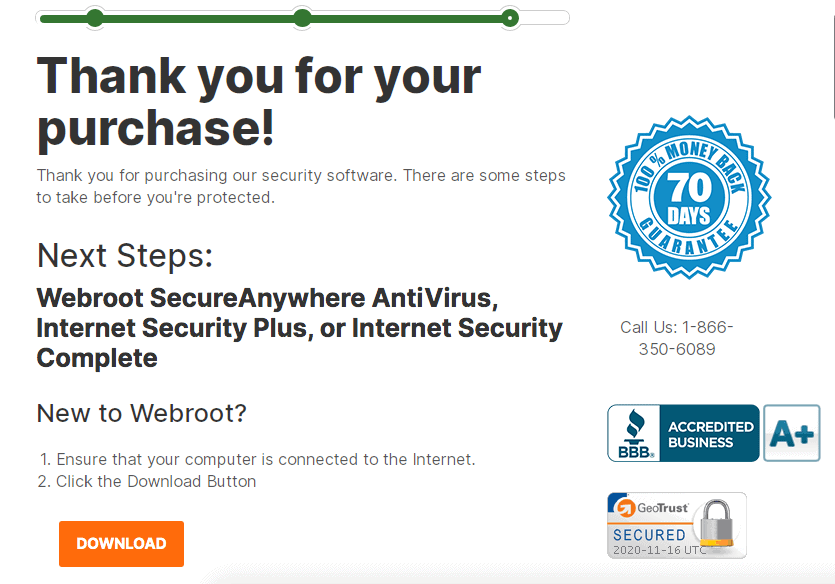
Overall, the Webroot app was lightweight and easy to use. It wasn’t like some of the antivirus apps we’ve tested that really slow down your computer, or run multiple processes in the background, causing delays. Everything was lightning quick with Webroot.
Our only qualm is that we had to switch back and forth the app and website to access some features. This took out some of the app’s user-friendliness, but it wasn’t a big issue and is certainly not a deal-breaker for us.
Did Webroot Detect Viruses and Malware?
Let’s get back to the basic function of antivirus software: how well did Webroot actually protect our computer?
To test, we loaded five pieces of malware into our laptop and ran a scan. Of the five we hid, Webroot found just one. That was disappointing, and was way below our passing score of three out of five.
Of course, we used a very limited sample, but third-party tests seem to confirm our findings as well. For example, AV Test, an independent antivirus testing lab we trust, gave Webroot a two out of six protection score in their last test as a result of Webroot’s failure to detect about a third of the 307 zero-day attack samples. Although Webroot did catch 98.9-percent of prevalent malware at the time, that’s still almost a full percentage point lower than the 99.8-percent industry average.
In short, Webroot has a tendency to be inefficient. It may be fast, but we think a more thorough malware scan would be better than a speedy but inefficient one.
Navigating Webroot: Our Experience
Although Webroot’s virus and malware detection were lacking, we did appreciate its user experience, which was pretty seamless in our opinion.
Downloading Webroot
We bought the “antivirus-only” plan from Webroot, which cost $37.49 for three devices for one year (if you want one device or a plan for two or three years, check out our Webroot pricing page to learn more about their options). After filling out our payment information on the Webroot website, we downloaded the app from the website directly (no intermediary installer app here!). Within a few seconds, the app was downloaded and began its first scan. Overall, this process was super smooth, which is not always the case for antivirus software. But how did it work after we got it downloaded?
Identity Protection
The next section was Identity Protection, which only included one feature called Phishing Shield.
- Phishing Shield: Enabled by default, Phishing Shield would’ve blocked any fraudulent websites that were meant to obtain our personally identifiable information. But again, we’re pretty good at recognizing phishing links, so this didn’t come up for us while browsing the web.
Backup & Sync
Between our Macbook Pro, Kindle Fire, iPhone and Smart TV with built-in Chromecast, we’re constantly toggling between different devices, and accessing files can be a bit of a pain to email back and forth. But since we didn’t buy the Internet Security Complete package, we didn’t actually pay for this 25 GB of cloud storage, so when we clicked on it, we were brought back to Webroot’s website in hopes of buying more software. The price was $59.99 for coverage of up to five devices for a year. While that’s decent value, in our opinion, we were happy with our current coverage. Many antivirus companies tack on extra features, like VPNs, secure storage or password managers to up the prices. Unfortunately, this sort of upselling is really common in antivirus software, but that doesn’t make it any less annoying.
Password Manager
Another feature only available in the two Internet Security packages is a password manager. Webroot’s password manager is powered by LastPass, which uses Touch ID to log into accounts rather than manually entering credentials. The sign-up process from the Webroot app is a bit clunky, at the end of which we discovered a simple Chrome extension integration…and a charge for the service (boo!). We already happen to have a LastPass subscription, but the Webroot Internet Security bundle is actually a better value. We wish we had known about it earlier!
>> Compare: Lastpass vs. Nordpass
Utilities
Under Utilities, we saw two buttons: Manage Active Processes and Reports. When we clicked on Manage Active Processes, we found a tab called System Control, which showed us all “Active Processes”, or files and web pages we had open, and whether or not they were allowed, monitored or blocked. The Reports section is divided into Scan Logs, which includes logs of our most recent scans. It also includes an area to submit files like screenshots when things go wrong, a way to help Webroot improve their products.
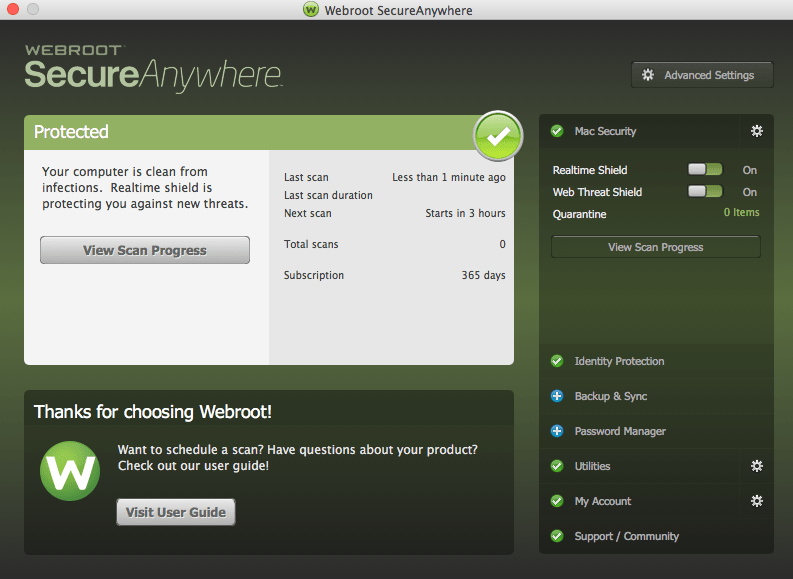
My Account
The Webroot app didn’t have all of its functionality built-in; rather, many features, like the password manager, required us to open the Webroot website. That’s where the My Account section came in. My Account provides access to the web console, keycode, subscription info and main support page on their website.
Support/Community
Last but not least was Support/Community, which included buttons to contact customer support and speak in user forums.
Webroot Costs
Here, we have the pricing for Webroot’s antivirus plan, but again, look at our pricing page for more options. Webroot also has plans for businesses and VPNs, so make sure you read about all the options at hand. There’s even an antivirus software for gamers!
| Maximum Number of Devices and Contract Lengths | Price |
|---|---|
| 1 device, 1 year | $29.99 |
| 1 device, 2 years | $59.99 |
| 1 device, 3 years | $89.99 |
| 3 devices, 1 year | $37.49 |
| 3 devices, 2 years | $79.99 |
| 3 devices, 3 years | $109.99 |
If you’re interested in protecting your identity, keep in mind that Webroot recently released Webroot Premium, an all-in-one service for families that includes the antivirus protections as well as up to $1M in stolen funds and identity fraud expense reimbursement, and 24/7 support with identity restoration specialists.
FYI: While the Internet Security Plus plan adds a password manager to the Antivirus Plan, Internet Security Complete adds protection against tracking plus 25 GB of cloud storage.
Webroot App
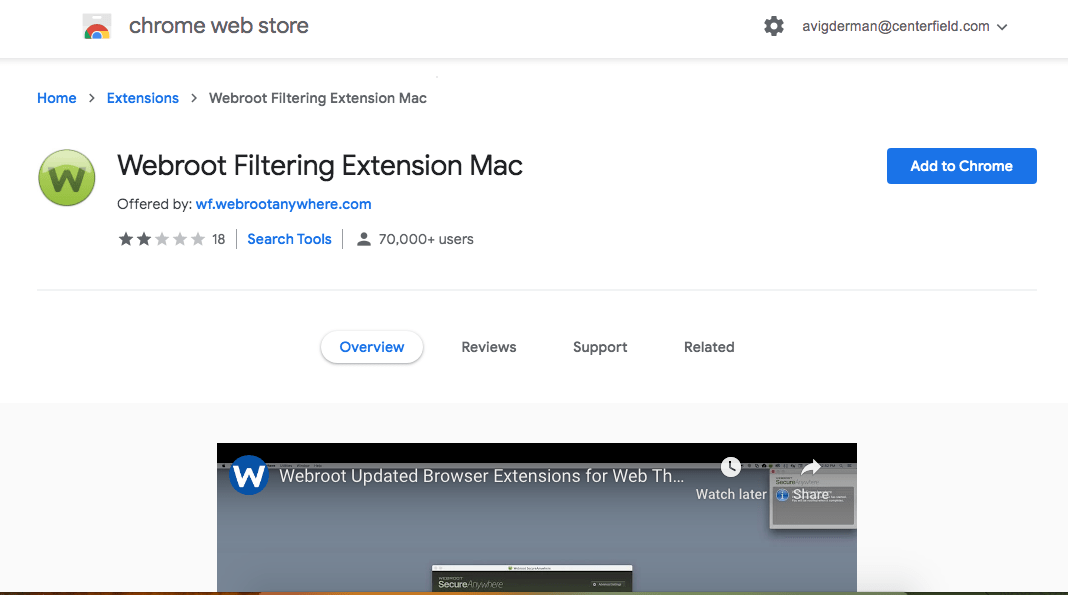
We tested our Webroot on our Macbook Pro, but they also have iOS and Android apps, both of which have ratings of 3.7 out of five on the Apple and Google Play stores. However, the apps are named differently:
- iOS: Webroot WiFi Security & VPN
- Android: Webroot Mobile Security & Antivirus.
These are decent but not great ratings; many Android-users, in particular, claimed that the app didn’t work on their tablets, so Webroot may be a better antivirus software for iPhone than it is for Android.
Customer Support
There were a few ways for us to contact Webroot’s customer support, including creating an online ticket, send them a message, calling them on the phone or simply checking out their online help center. While we wish they had live chat as well, we found their support page to be pretty clearly laid out and extensive.
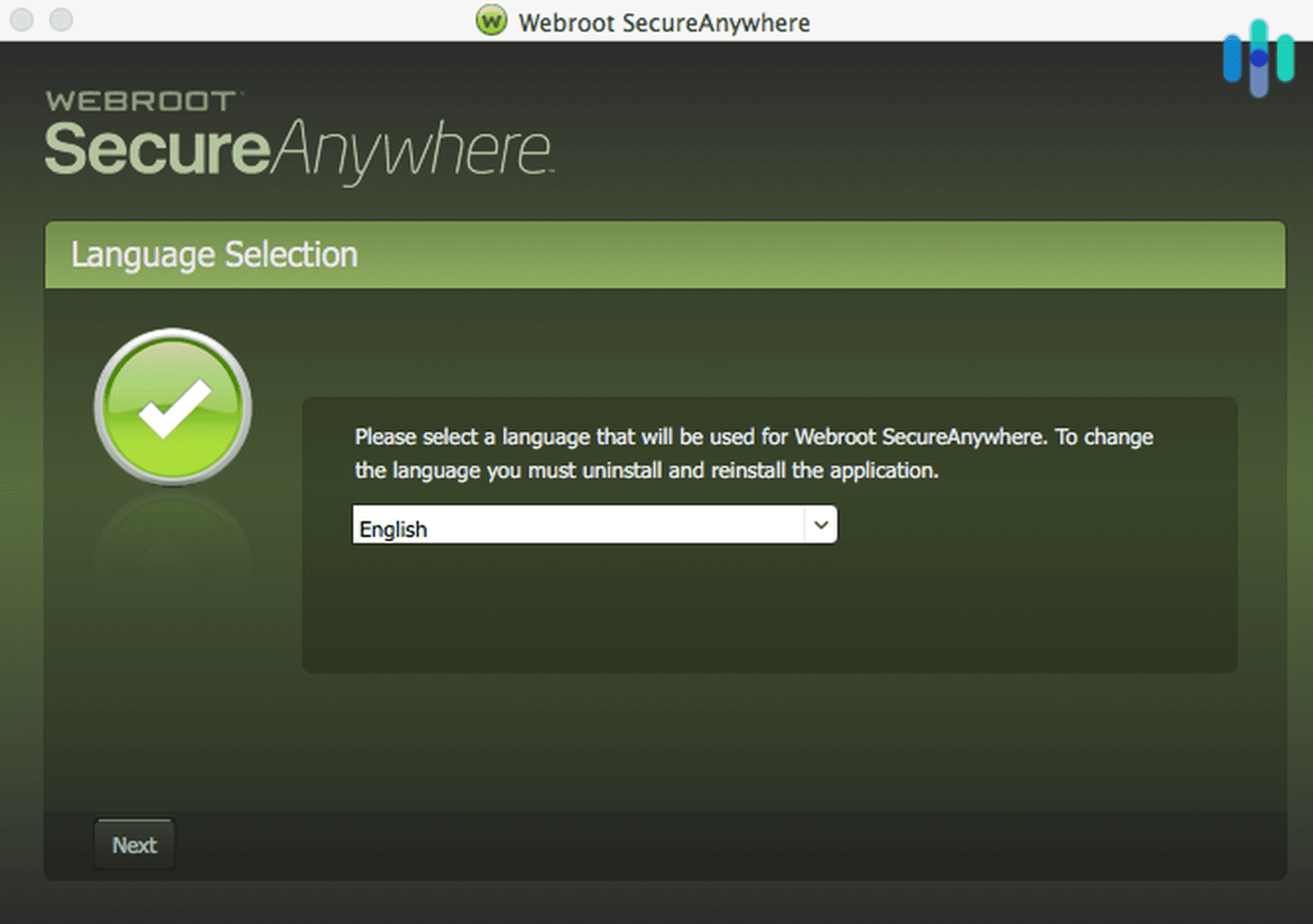
Our Webroot Research and Data
The following is the data and research conducted for this review by our industry-experts. Learn More.
Encryption
| In Transit | Yes with certain products |
|---|---|
| At rest? | Yes with certain products |
| All network communications and capabilities? | Yes with certain products |
Security Updates
| Automatic, regular software/ firmware updates? | Yes |
|---|---|
| Product available to use during updates? | Yes |
Passwords
| Mandatory password? | Yes |
|---|---|
| Two-Factor authentication? | Yes |
| Multi-Factor authentication? | Yes |
Vulnerability Management
| Point of contact for reporting vulnerabilities? | Submit a report through the portal |
|---|---|
| Bug bounty program? | Vulnerability disclosure program that may include reward |
Privacy Policy
| Link | https://www.webroot.com/us/en/legal/privacy |
|---|---|
| Specific to device? | Yes |
| Readable? | Yes |
| What data they log | Name, mailing address, email address, telephone number, payment information, IP address, browser information, browsing history, operating system information, login information, website usage information, potentially malicious files, and cookies. |
| What data they don’t log | n/a |
| Can you delete your data? | Yes |
| Third-party sharing policies | Shares information with third parties. |
Surveillance
| Log camera device/ app footage | n/a |
|---|---|
| Log microphone device/ app | n/a |
| Location tracking device/ app | Yes |
Parental Controls
| Are there parental controls? | No |
|---|
Company History
| Any security breaches/ surveillance issues in past? | Yes |
|---|---|
| Did they do anything to fix it? | Yes |
Additional Security Features
| Anything like privacy shutters, privacy zones, etc.? | Can opt out of sharing potentially malicious files |
|---|
Summary
Given their low virus and malware detection, we don’t recommend Webroot overall. However, we’d be willing to reconsider if Webroot improved its detection. As it did have a pretty seamless user experience, we didn’t dislike everything about the software. However, when it came to that core antivirus and anti-malware functionality, Webroot missed the mark.
-
MSSP Alert. (2019). Hackers Hit MSP Software to Launch Ransomware Attacks.
msspalert.com/cybersecurity-breaches-and-attacks/ransomware/hackers-hit-msp-software/ -
Webroot. (2020). WSA Privacy Statement.
cdn.webroot.com/2015/8152/3342/Webroot_WSA_Privacy_Statement_-_12_February_2020.pdf





